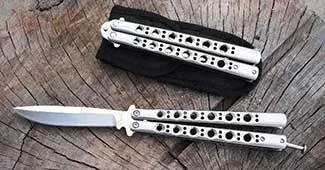The Balisong and the Old Knife-Making Rivalry between Taal and Lipa
The blacksmithing industry in the Philippines likely predates the arrival of the Spaniards. A 1590 manuscript called the Boxer Codex1, which was something of an instruction manual on the Philippines and other Far Eastern countries at the time, contained textual and pictorial descriptions of the Philippine ethnic groups known to the Spaniards.
The manuscript described the “Moros” – as the earliest conquistadores referred to the natives of the Philippines – among the Tagalos (or Tagalogs, and there was every likelihood that the unknown author of the codex was describing the people of what is present day Batangas) as having “carpenters, blacksmiths, jewelers and other artisans to make bronze cannons…2”
 |
| Image credit: By Iamthawalrus - Own work, CC BY-SA 3.0, https://commons.wikimedia.org/w/index.php?curid=30337122. |
The codex also stated that cannons that were created by blacksmiths were confiscated by the Spaniards; and presumably local iron workers were banned from creating any more of these for obvious reasons. Household industries for the creation of implements, however, were allowed to continue so that even through to the American era, there were towns known for their production of iron products.
One of these was Taal. A 1916 paper3 written by one Galicano C. Luansing said, “There are also a number of blacksmith shops (in Taal) in which bolos and small iron tools are made.” These were aside from other products that Taal was known for such as baskets, mats, sacks, leather products, slippers, cotton cloths and towels, panucha and many other goods.
 |
| Some of the iron products of Taal. Image credit: Weapons and Implements Made and Used in the Town of Taal by B.B. Atienza. |
Another paper4, this time written by one B.B. Atienza in 1917, gave more details about the various weapons and tools that were manufactured by the blacksmiths of Taal. Many of these were for use agricultural use but one, a sword with a wavy blade called the kris which was more commonly associated with the southern Philippines, was also being manufactured.
The balisong, the fan knife which in time would become Taal’s most iconic iron product, was not among the products included. This was likely because production of the iconic knife had yet to become widespread. It was not until 1905 that the first balisong was created in Taal by one Perfecto de Leon, who explained that he was forced to craft it because of a failing bolo manufacturing business5.
 |
| Perfecto de Leon, manufacturer of the first Batangas fan knife. Image used with permission by the owner Jigger Gilera, M.D. |
The knife’s name was supposed to have been taken from the barrio to the east of Taal where de Leon manufactured his first balisong. Whether or not de Leon was the inventor of the fan knife, however, is contentious.
In 1880, a patent was issued in England to a German cutlery firm named Bontgen and Sabin’s with a description unmistakably that of a fan knife, ““The handle consists of two shells, which are pivoted to the blade and completely enclose it when shut, being held together by a clasp. When open, the two parts are also held by the clasp, and the recesses fit on either side of the pin on the blade6.”
With the passing of time, the balisong became increasingly popular until it would ultimately be among the Batangueño’s most recognizable symbols. Its manufacture spread from the barrio of Balisong to the neighboring barrios of Pook, Buli and Tulo.
The Batangas-made knife even started to attain some measure of international fame towards the end of World War II in the Philippines. American soldiers who were part of the United States Sixth and Eighth Armies during the liberation of Batangas saw the balisong being used by locals and many brought these back home to the United States, probably as souvenirs.
Demand for the balisong started to rise internationally so that at one point, these were being exported abroad. In the end, it did not matter if de Leon was the inventor of the fan knife because demand for the Batangas-made knife far exceeded that of knives which were manufactured in Europe.
Unfortunately, small and handy that the balisong is, it would also become standard issue to criminals and members of gangs. So much so that the United States government ultimately felt impelled to ban its import7 along with other switchblades in 1958.
What is not so well known these days was that there used to be a standing rivalry between the towns of Taal and Lipa in the manufacture of knives, something that de Leon himself elaborated on. While the pioneer balisong-maker admitted that the “lanceta” (small knives) were produced in Lipa ahead of Taal, he denied that the fan knife or balisong was first created there.
Speaking to writer Ciriaco Ave Arcega5, de Leon would say that there was for several years keen competition between barrio Balisong and Lipa. He went on, “We kept improving our knives; and we outsold them in the market. We defeated them through years of rivalry in craftsmanship. That was in the early twenties.”
2 “Boxer Codex,” author unknown, written c. 1590.
3 “Industries of Batangas Province,” by Galicano C. Luansing, published 1916, online at the Henry Otley-Beyer Collection of the National Library of the Philippines Digital Collections.
4 “Weapons and Implements Made and Used in the Town of Taal,” written 1917 by B.B. Atienza, online at the Henry Otley-Beyer Collection of the National Library of the Philippines Digital Collections.
5 Along with other important details of this article, from “They ‘Live’ on Balisong,” by Ciriaco Ave Arcega.
6 “The History of the Balisong,” by Audra Draper, MS, online at “The Balisong Collector’s Page.”
7 “Balisong History,” online at Pinoy Steel.
